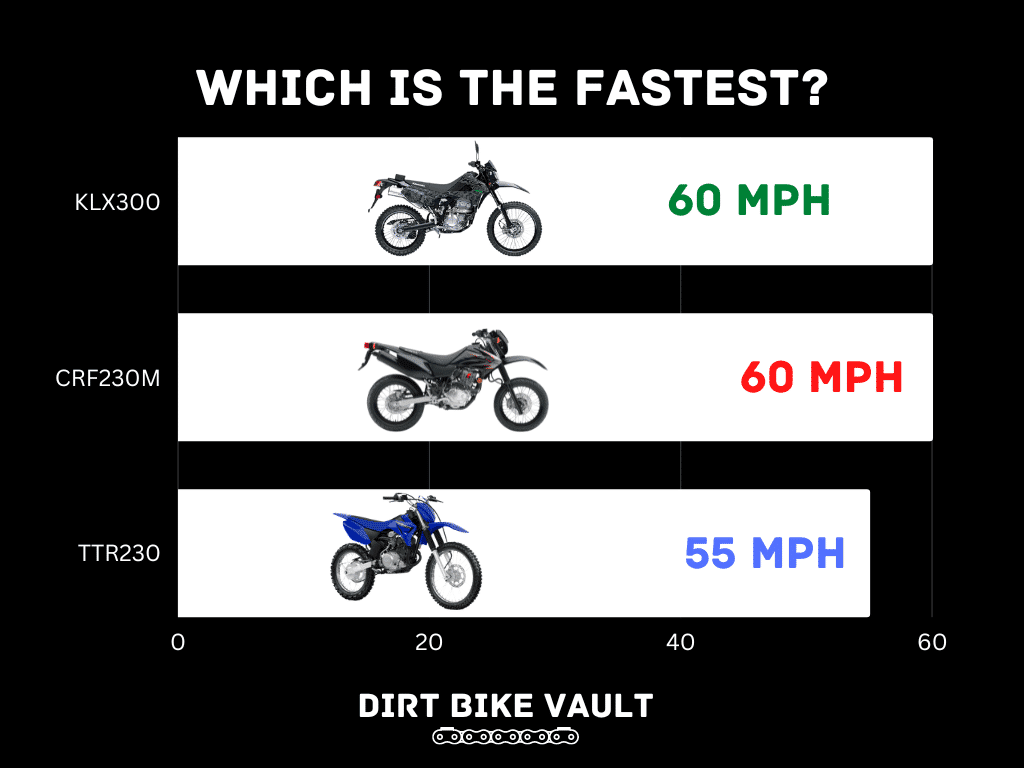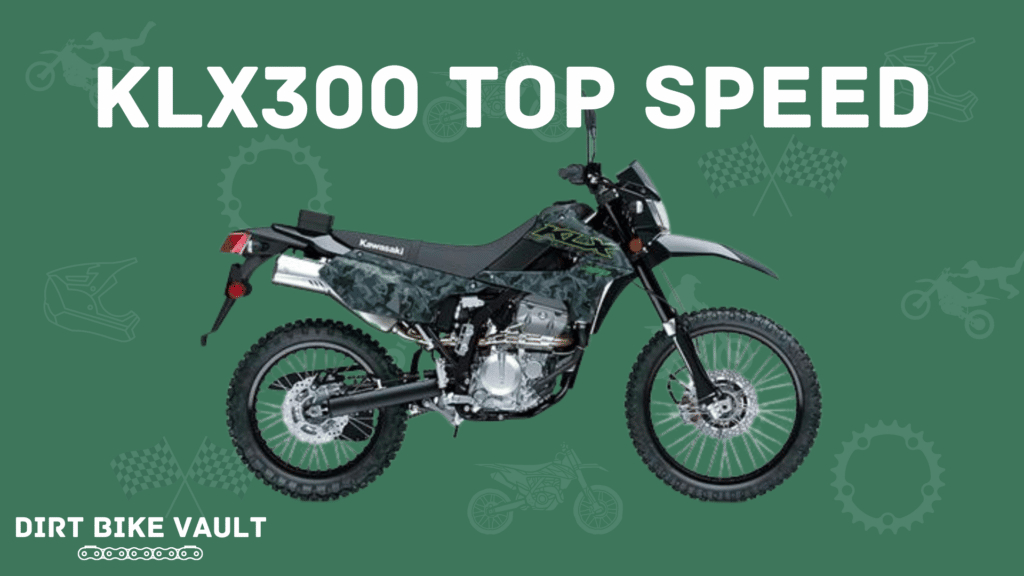If you’re into motorsports (cars, trucks, dirt bikes, etc.), even a dual-sport like a KLX 300, you’re almost guaranteed to want to know how fast it goes. As dirt bike riders, we need to know how fast our bikes go. In this article, we’ll be covering the top speed of KLX 300.
KLX 300 top speed
Kawasaki has long been a dominant brand in the dirt bike world, but what does this mean for the KLX 300 top speed?
The KLX 300 top speed is about 60-65 mph.
This is about the same as the CRF230M top speed. It’s also about 5 mph faster than the TTR 230 top speed.
Why did I pick these two bikes to compare the KLX 300?
The CRF230F was chosen to compare to the KLX 300 because there is a model of the CRF230M that is a dual-sport bike as well, just like the KLX300. It’s slightly underpowered (70 fewer cc’s), but it’s a comparable bike.
The TTR 230 was chosen to compare to the KLX300 because it’s similar to the “off-road portion” of the KLX300. Of course, the KLX300 is a dual-sport and can be ridden on both the street and dirt, while the TTR 230 is only a dirt bike, but you can at least compare the KLX300 in the dirt to the TTR230 in the dirt.

What changes the top speed of KLX300?
It can be tough at times to calculate the true top speed of a dirt bike because there are quite a few different items that can impact it. Let’s take a look at them.
Modifications
This might be obvious to some, but engine work and aftermarket parts are going to impact the KLX 300 top speed. Arguably, most of anything.
If your KLX 300 has engine work (especially a big bore kit) and a pipe, that’s not really comparable to the top speed of a stock KLX 300.
The top speed of KLX300 that hasn’t had any work done to it will be significantly lower than the top speed of a bike that has undergone mods.
The more work you do to the bike, the greater the difference in speeds will be.
There are other factors at play here too – such as gearing, riding conditions, and more.
Know someone who should read this? Text it to them.
Gearing
The second most important factor in determining the KLX 300 top speed is its gearing. Gearing refers to the size (and ratio) of the front and rear sprockets.
For reference, the stock gearing for this bike is a 14-tooth front sprocket and a 50-tooth rear sprocket (depending on the year of your bike).
Riders normally pick different gearing depending on the situation they’re riding. If the rider is racing supercross (which they won’t do with a KLX300, but for illustrative purposes, stick with me…), they would typically want more acceleration (referred to as more bottom end). To achieve this, they’d use either a smaller front sprocket or a larger rear one. This is known as having a low gear ratio.
If the rider is racing motocross, they may want more top speed (known as top end). To do this, the rider would use a larger front sprocket or a smaller rear sprocket; in other words, they would be changing to a higher gear ratio.
Riding in the woods can require an entirely different gearing combination than that of supercross or motocross.
This might not sound like much to some people, but it has a large impact on the top speed of KLX 300 (or any dirt bike, for that matter). Depending on the gear changes made, it can increase or decrease the KLX 300 top speed by more than 3-5 mph.
A KLX 300 with a 8-tooth front sprocket will have a different top speed than one with the stock 14-tooth front sprocket (I made the difference wide to make a point — no one is running a 8-tooth front sprocket on their KLX 300….).
Additionally, a change to the front sprocket has a great effect on the KLX 300 top speed and bottom end than changing the rear sprocket. Going up or down one tooth on the front sprocket is not equal to one tooth on the rear sprocket.
Rather, changing the front sprocket by one tooth is equivalent to 3-4 teeth in the rear.
Rider
The top speed of KLX300 is going to be slower if the rider weighs more because it takes more work from the bike, while the bike and engine maintain the same ability/capacity. The heavier the rider, generally the lower the KLX 300 top speed is going to be.
In addition, an experienced rider can make the KLX 300 go faster than a beginner who is just learning. A rider who knows how to quickly and smoothly shift gears can hit a higher top speed than someone who is just learning how to use a clutch.
Conditions of Riding
The KLX 300 top speed can also be impacted by riding conditions, including both location and surface.
For example, a dirt bike’s power output is generally higher closer to sea level than at high altitudes. So if you’re planning to ride your KLX 300 in the mountains, it will likely have a lower top speed than if you were riding at sea level.
Or, even if you’re not in the mountains necessarily, but you’re just riding in Colorado, you’re much higher above sea level than the coasts of the US. That will cause your KLX 300 top speed to be lower.
Are you riding in the woods, on a motocross track, or on a paved road? If it’s in the woods, your top speed might be limited. If you’re racing motocross, you can only go so fast while remaining safe and within bounds (and, don’t forget, sometimes slow is fast).
You’re likely mostly riding your KLX300 on the road. That’s going to be different than the woods and a motocross track that was just mentioned.
Apart from the elevation and location, another factor that affects the KLX 300 top speed is the surface on which it is being ridden. The top speed of KLX300 ridden on flat pavement will be different than if it were driven on a tight, sandy motocross course; even the type of tires can make a difference.
A Few Other Factors that Can Impact the KLX 300 top speed
Your KLX 300 top speed can also be impacted by a few more things, including the condition of your bike, the weather, and how you’re recording the data.
A bike that is regularly maintained will run faster and more efficiently than one that isn’t. For example, a KLX 300 that has had consistent maintenance done to it will be able to reach a higher top speed than one not taken care of properly.
The weather and temperature can both affect your KLX 300 top speed. If it rains, the pavement will be wet and your top speed will probably be lower than normal.
If you want to get an accurate reading of the top speed of KLX300, use an onboard GPS device rather than relying on someone pointing a speed gauge at you as you zoom past. This doesn’t mean the bike will actually go any faster or slower, it just changes what you end up seeing on paper.
Waving the White Flag on the top speed of KLX300
As we pass by the white flag of this article and enter into the last lap, we want to summarize what we’ve covered so far.
Ultimately, most people want to know their bike’s rough top speed. Yes, mods and other items impact a KLX 300 top speed potential, but at the end of the day, people just want to have an idea of how fast their bike is.
With that in mind, a KLX 300 top speed is about 60-65 mph.
Frequently Asked Questions About the KLX 300 Top Speed
The Kawasaki KLX 300 can go about 60-65 miles per hour. Modifications to your KLX300 or the riding conditions you’re in will impact how fast the Kawasaki KLX 300 can go.
I wouldn’t say the KLX300 is slow, but it’s all relative. The KLX300 is slow compared to a 1000cc street bike motorcycle, but it’s fast compared to a KLX110.



